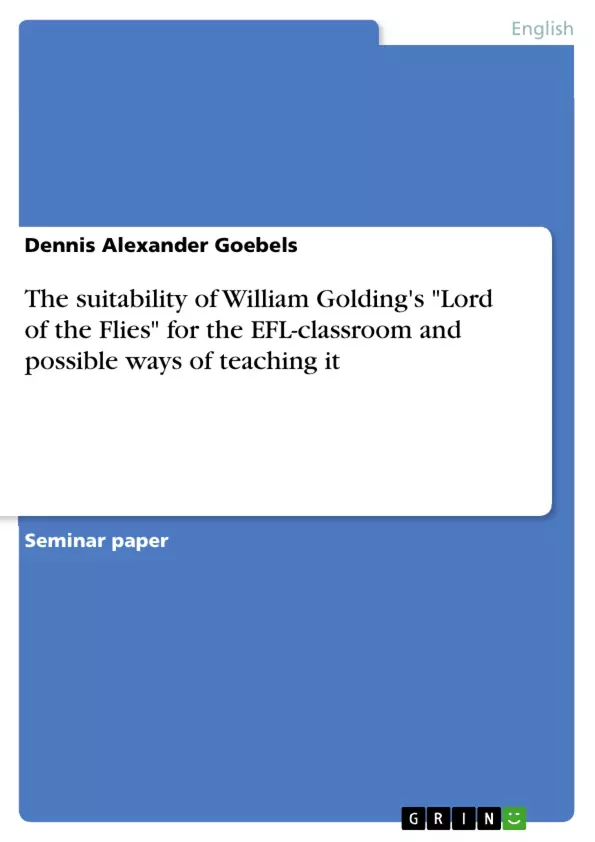Few texts have been taught and dealt with more in school than William Golding’s Lord of the Flies (1954). It has been part of the unofficial `school-canon’ for more than three decades now and therefore it is useful to examine the suitability of this text for the EFL-classroom. This will be done by introducing the criteria for selecting texts given in Engelbert Thaler’s Teaching English Literature, adding some elements from Ansgar Nünning’s and Carola Surkamp’s Englische Literatur Unterrichten. Grundlagen und Methoden and applying both to Lord of the Flies. First, a short summary of the plot will be given before the text will be analyzed with reference to its appropriateness for the EFL-classroom. This analysis will take place in four steps: First, the formal aspects will be taken into account, and then the thematic aspects will be discussed. Thirdly, the aspects related to reception will be illuminated. At the end a conclusion will be drawn whether or not for me Lord of the Flies is a suitable text for the EFL-classroom. In the course of the paper there will be given some hints as to how a certain aspect could be investigated further in the EFL-classroom. These hints are by no means a complete list and several aspects could be added to it. The decision which aspects should be included and which should be left out is up to the teacher who has to decide with regard to the amount of time he wants to spend on Lord of the Flies and with regard to the preconditions in his class
Inhaltsverzeichnis (Table of Contents)
- Introduction
- The Suitability of William Golding's Lord of the Flies for the EFL-classroom and Possible Ways of Teaching it
- Summary of the plot
- Formal aspects
- Length
- Linguistic difficulty
- Thematic aspects
- The main characters
- Important ideas/themes and inherent problems
- The Ending
- Aspects related to reception
- Availability of the text
- Curricular conformity
- Methodological material
- Conclusion
Zielsetzung und Themenschwerpunkte (Objectives and Key Themes)
This paper examines the suitability of William Golding's Lord of the Flies for use in the EFL classroom. The author analyzes the text based on criteria for selecting texts for teaching English literature, drawing upon various pedagogical approaches. The main goal is to determine whether the novel is appropriate for EFL learners, considering aspects like formal features, thematic content, and reception.
- Formal aspects of the text, including length and linguistic complexity
- Thematic depth and the relevance of the explored ideas to EFL learners
- The potential of the text for promoting language development and enriching vocabulary
- The suitability of the novel for various teaching approaches and its potential for multidisciplinary projects
- The potential of the text to address relevant concerns for EFL learners, such as cultural awareness and intercultural understanding
Zusammenfassung der Kapitel (Chapter Summaries)
- The introduction provides an overview of the topic, outlining the selection criteria for texts in EFL teaching and the methodology used in the analysis of Lord of the Flies. It also introduces a brief summary of the novel's plot.
- The chapter on formal aspects discusses the novel's length and its suitability for different teaching approaches, including a "straight through" approach, a "segment approach," and a "sandwich approach." It also analyzes the linguistic complexity of the text, considering both syntactical and semantic features.
- The chapter on thematic aspects explores the novel's main characters, Ralph and Jack, and their development throughout the story. It also delves into the important ideas and themes that emerge from the narrative, highlighting the novel's potential to provoke thought and discussion.
- The chapter on aspects related to reception examines the availability of the text, its conformity to EFL curricula, and the availability of methodological materials for teaching Lord of the Flies.
Schlüsselwörter (Keywords)
This paper focuses on the suitability of Lord of the Flies for the EFL classroom, examining the text's formal features, thematic depth, linguistic complexity, and potential for promoting language development and multidisciplinary projects. The analysis considers aspects like character development, the exploration of core themes, and the novel's suitability for different teaching approaches. It explores the potential of the text to enhance vocabulary and facilitate cultural awareness.
- Arbeit zitieren
- B.A. Dennis Alexander Goebels (Autor:in), 2009, The suitability of William Golding's "Lord of the Flies" for the EFL-classroom and possible ways of teaching it, München, GRIN Verlag, https://www.grin.com/document/143929



